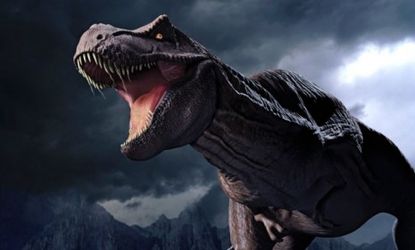Why Tyrannosaurus rex would rip Triceratops' head off
New fossil findings suggest T-rex would dismember downed foes to get at the tender neck meat hiding beneath the massive frilly skull

Prehistoric clashes between Tyrannosaurus rex and the heavily armored Triceratops likely made for "the most fearsome battle[s] to ever take place in the animal kingdom," says George Dvorsky at io9. But given that the Triceratops' head is essentially an elaborately pronged, inedible shell, "it has never been clear how the T-rex was able to penetrate through the thick shielding when it came time for the feast." New fossil evidence suggests that whenever the horned herbivore succumbed to its hulking enemy, T-rex would essentially rip its victim's head off to get at the good stuff underneath. Here, a guide to the grisly new findings:
Did T-rex and Triceratops really square off?
Whether the two iconic Cretaceous-era dinosaurs really battled is a point of contention among experts. Some paleontologists speculate that Triceratops' elaborate skull, seemingly built for battling predators, was really designed for mating purposes or fighting off other male suitors. Others theorize that the T-rex, rather than attacking its prey as depicted in films, was really more of a scavenger, feeding off the corpses of already dead dinos. One thing is certain, however: T-rex ate Triceratops. And when it did, says io9's Dvorsky, "it wasn't pretty."
Subscribe to The Week
Escape your echo chamber. Get the facts behind the news, plus analysis from multiple perspectives.

Sign up for The Week's Free Newsletters
From our morning news briefing to a weekly Good News Newsletter, get the best of The Week delivered directly to your inbox.
From our morning news briefing to a weekly Good News Newsletter, get the best of The Week delivered directly to your inbox.
What led the experts to conclude that the T-rex was tearing off the Triceratops' head?
Denver Fowler and a team of paleontologists at the Museum of the Rockies in Bozeman, Montana, were studying Triceratops specimens when they noticed something strange: Evidence of the T-rex's distinctive teethmarks, all over the skulls. Significantly, none of the marks showed any evidence of healing, "indicating the bites were inflicted on dead animals that were in the process of being eaten," says Matt Kaplan at Nature. After closer study, Fowler and his team concluded that the T-rex's real goal was the Triceratops' tender, nutrient-rich neck meat. "It's gruesome, but the easiest way to [get at this meat] was to pull the head off," says Fowler.
How exactly did the process work?
In four steps: First, T-rex repositioned itself so it could grip the frilly collar-like portion of the Triceratops' skull. Second, T-rex would start pulling the skull up, ripping the tendons in its victim's neck and loosening things up for the head-ripping to come. ("Fowler believes that the T-rex's laterally thickened tooth structure… substantially improve[d] its ability to dismember carcasses," says io9's Dvorsky.) After that, T-rex would grab onto the face with its massive jaw and pull Triceratops' head off. Finally, T-rex would start chowing down on the exposed neck flesh, while occasionally gnawing on Triceratops' face.
Sources: ABC News, Daily Mail, io9, Los Angeles Times, Nature
Create an account with the same email registered to your subscription to unlock access.
Sign up for Today's Best Articles in your inbox
A free daily email with the biggest news stories of the day – and the best features from TheWeek.com
-
 Today's political cartoons - April 20, 2024
Today's political cartoons - April 20, 2024Cartoons Saturday's cartoons - papal ideas, high-powered debates, and more
By The Week US Published
-
 5 sleeper hit cartoons about Trump's struggles to stay awake in court
5 sleeper hit cartoons about Trump's struggles to stay awake in courtCartoons Artists take on courtroom tranquility, war on wokeness, and more
By The Week US Published
-
 The true story of Feud: Capote vs. The Swans
The true story of Feud: Capote vs. The SwansIn depth The writer's fall from grace with his high-flying socialite friends in 1960s Manhattan is captured in a new Disney+ series
By Adrienne Wyper, The Week UK Published